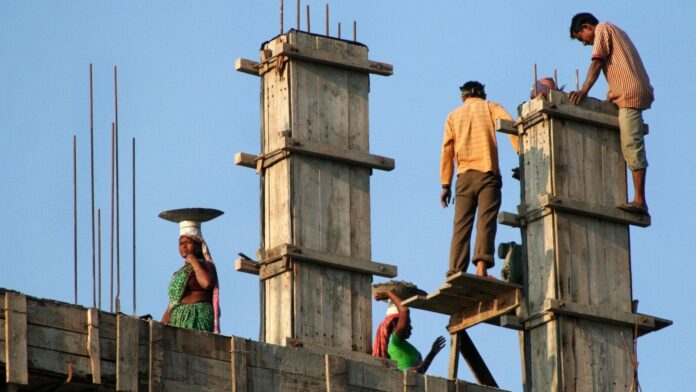With L&T employing around 400,000 labourers, Subrahmanyan is not an uninformed bystander. But his argument deserves scrutiny. The government’s advance estimates put construction growth at 8.6% this fiscal year—34% faster than overall economic growth of 6.4%. If labour shortages were truly stalling construction, could the sector have outpaced the broader economy?
Read this | Rural jobs scheme, direct benefit transfers causing labour shortages: L&T chair
Perhaps, if construction companies had access to the full complement the workers they were seeking, growth might have been even stronger. But this must be viewed in the context of a housing market dominated by luxury and high-end segments, while the affordable housing sector remains weak and in need of targeted support—an issue the real estate industry has flagged to the finance minister ahead of the Union budget.
Rather than blaming welfare for keeping workers in villages, Subrahmanyan should focus on the lack of support systems for migrant labourers in the urban and peri-urban areas where construction is concentrated. The memory of the pandemic-induced lockdown, which left countless workers stranded without income or aid, still looms large. For many, ‘once bitten, twice shy’ is more than just a saying—it’s a reality shaping their choices.
Outside of Kerala and parts of Tamil Nadu, local authorities did little to support the migrant workers who kept host cities running. When the Centre imposed a strict lockdown, these workers were left to fend for themselves. Hundreds of thousands embarked on gruelling journeys back to their villages, walking for days—only to return to a life of underemployment and bare subsistence.
For many labourers, the choice is clear: the certainty of survival and family support in their villages outweighs the uncertainty of work and sustenance in distant cities. Welfare transfers, though meagre, provide a degree of security that urban employment often does not.
However, this equation can shift if wages are high enough—not just to offset the hardship of migration but also the risk of being abandoned again in a crisis. Studies on Universal Basic Income have found that people naturally prefer work over living on subsidies. The challenge is ensuring that work offers both stability and dignity.
Read this | 90 hours per week: What’s with this foot in the mouth
All the talk of benefit transfers directly to beneficiaries’ bank accounts gives the impression that technology has dumped all leakages and middlemen in the dustbin of history. The impression is pure delusion. To qualify as a beneficiary of a welfare payment, the local panchayat head and village officer must make such a recommendation. To withdraw money from one’s bank account, a percentage must be shared with those assisting or enabling that withdrawal. Subsidies do provide support, but these come with strings attached.
These constraints add to the hardship of staying in the village, where employment opportunities in agriculture are scarce, and even those available offer little more than subsistence. Welfare may provide a safety net, but it is far from a comfortable or reliable alternative to stable urban jobs.
People naturally prefer work over subsidies. Even more, they value the certainty of life and well-being over unmitigated risk. Migration is a trade-off between risk and reward—one that workers will make only if the rewards outweigh not just the hardship of relocation but also the very real risk of being stranded in a crisis.
The real solution to the labour shortage lies in raising wages and lowering risks. Urban job markets need built-in safety nets, not just for pandemics but also for other disruptions—extreme heat waves, floods, or any event that halts work and wages.
The portable ration card system envisioned during the pandemic must be fully implemented. Food subsidies—whether free or at reduced prices—should be linked to individuals rather than households, ensuring that migrants can access their entitlements wherever they are. Currently, ration cards are issued at the family level, typically tied to their home village, making it difficult for migrant workers to claim benefits in cities.
Aadhaar integration makes portability feasible, and the broader digital public infrastructure can extend beyond rations to include healthcare, retirement savings, and other social benefits. Skilling programmes could serve as an additional incentive, helping migrants secure better-paying jobs. But these reforms must go further.
“Since the implementation of the Building and Other Construction Workers (Regulation of Employment and Conditions of Service) Act in 2005, the boards have collected ₹1,17,507.22 crore as cess from the employers and allocated ₹67,669.92 crore with the workers,” said a response to an RTI query on the subject, according to a news report.
Also read | How construction and polls helped in a year of muted rise in NREGA spending
These state boards should be integrated into the National Pension System, ensuring that contributions also cover non-pension benefits like health, accident, and life insurance. The existing state-level boards end up locking up the money collected from the likes of L&T for the welfare of their workers instead of using the funds for the workers’ benefit.
India is still too young and poor for rural inertia to outweigh urban opportunity—if the incentives are right. A slightly higher wage for construction workers wouldn’t just ease labour shortages but also put more money in the hands of consumers, boosting demand across the economy.
#LTs #Subrahmanyan #worry #supporting #migrant #workers
